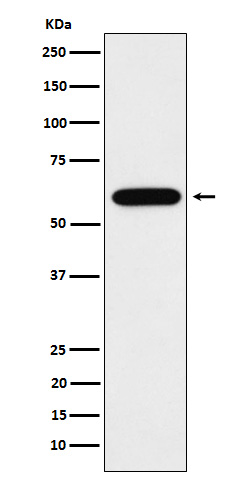
| WB | 咨询技术 | Human,Mouse,Rat |
| IF | 咨询技术 | Human,Mouse,Rat |
| IHC | 1/100-1/200 | Human,Mouse,Rat |
| ICC | 技术咨询 | Human,Mouse,Rat |
| FCM | 咨询技术 | Human,Mouse,Rat |
| Elisa | 咨询技术 | Human,Mouse,Rat |
| Aliases | rd5; TUB 1; TUB;;Tubby protein homolog |
| WB Predicted band size | Calculated MW: 56 kDa ; Observed MW: 60 kDa |
| Host/Isotype | Rabbit IgG |
| Antibody Type | Primary antibody |
| Storage | Store at 4°C short term. Aliquot and store at -20°C long term. Avoid freeze/thaw cycles. |
| Species Reactivity | Human,Mouse,Rat |
| Immunogen | A synthesized peptide derived from human Tubby protein homolog |
| Formulation | Purified antibody in PBS with 0.05% sodium azide,0.05% BSA and 50% glycerol. |
+ +
以下是关于TUB1抗体的3篇参考文献的简要列举:
1. **"Characterization of the β-tubulin gene family in Saccharomyces cerevisiae"**
- **作者**: Thomas, J.H. 等人
- **摘要**: 研究通过TUB1抗体分析酿酒酵母中β-微管蛋白的亚细胞定位,揭示了TUB1在微管组装和有丝分裂中的关键作用,并验证了抗体在免疫荧光中的特异性。
2. **"Antimicrotubule drugs inhibit yeast mitosis by binding to β-tubulin"**
- **作者**: Barnes, G. 等
- **摘要**: 利用TUB1抗体进行免疫印迹实验,证明抗微管药物(如苯菌灵)通过结合TUB1蛋白破坏酵母的微管动力学,导致细胞周期停滞。
3. **"Functional analysis of tubulin isotypes in neuronal development"**
- **作者**: Smith, L.M. 等
- **摘要**: 在果蝇模型中,使用TUB1抗体研究β-微管蛋白同工型在神经元轴突生长中的差异表达,发现TUB1缺失导致轴突导向缺陷。
4. **"A yeast tubulin mutation suppresses microtubule-dependent motility defects"**
- **作者**: Huffaker, T.C. 等
- **摘要**: 通过TUB1抗体验证突变体菌株的微管稳定性,发现特定TUB1突变可恢复因微管解聚引起的细胞运动功能异常。
以上文献均涉及TUB1抗体的实验应用,涵盖酵母模型、药物机制及神经发育等领域。如需具体文献来源,建议通过PubMed或期刊数据库检索标题及作者进一步获取。
×